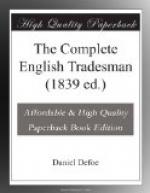[48] [In consequence of the great extension of commerce since the time of Defoe, a short explanation of the principle and practice of drawing foreign bills of exchange now seems necessary. Foreign bills of exchange are used, in order to avoid the necessity of transmitting actual money from one country to another. A merchant, for instance, in Nova Scotia, is owing L100 to a manufacturer in Glasgow: he seeks out some one who is a creditor to that amount to some person in Britain; we shall say he finds a captain in the army who wishes to draw L100 from his agent in London. To this captain the Nova Scotia merchant pays L100, and gets his order or bill on the London agent, which bill he sends to the manufacturer in Glasgow, and the manufacturer transmits the bill to London for payment; any banker, indeed, will give him the money for it, deducting a small commission. Thus two debts are liquidated, without the transmission of a farthing in money. The demand for bills in foreign countries to send to Great Britain, has the effect of raising them to a premium, which is called the rate of exchange, and is a burden which falls on the purchaser of the bill. Foreign bills of exchange drawn on parties in Great Britain, have expressed upon them the number of days after sight at which they are to be payable. Thus, a merchant on receiving a foreign bill drawn at ‘thirty days after sight,’ hastens to get it ‘sighted,’ or shown to the party on whom it is drawn, and that party accepts it, at the same time marking the date of doing so. The bill is then complete and negociable, and is presented for payment to the acceptor at the end of the time specified, allowing the usual three days of grace. Should the bill not be accepted on being ‘sighted,’ it is a dishonoured bill, and is returned with a legal protest to the foreign correspondent. To avert, as far as possible, the loss of foreign bills by shipwreck, a set of three bills is drawn for each transaction, called first, second, and third, of the same tenor. For example: ’Thirty days after sight pay this my first bill of exchange, for the sum of L100 sterling; second and third of the same tenor being unpaid.’ This first bill is first sent, and by next conveyance the second is sent. Should the first arrive safely, the second, on making its appearance, is destroyed. The third is retained by the foreign correspondent till he hear whether the former two have arrived at their destination, and is sent only if they have been lost. On receiving whichever comes first, it is the duty of the receiver to communicate intelligence of the fact to the sender.]



